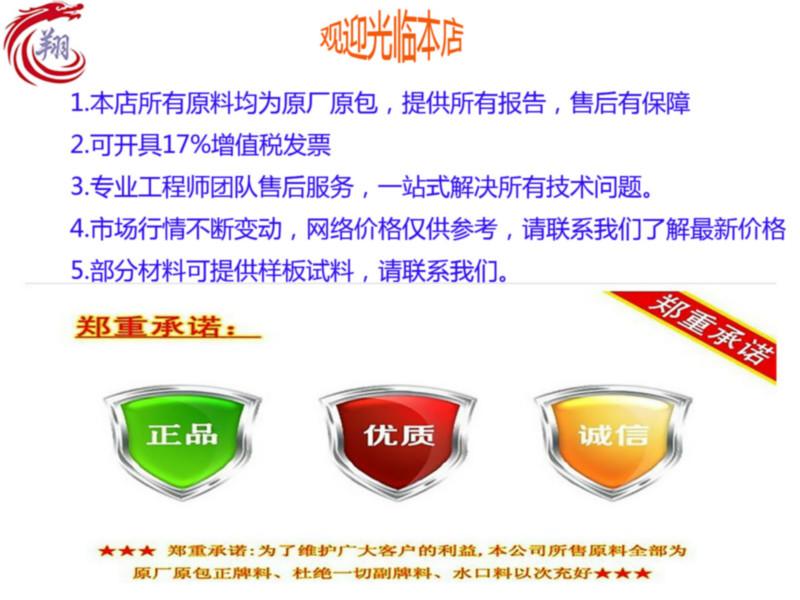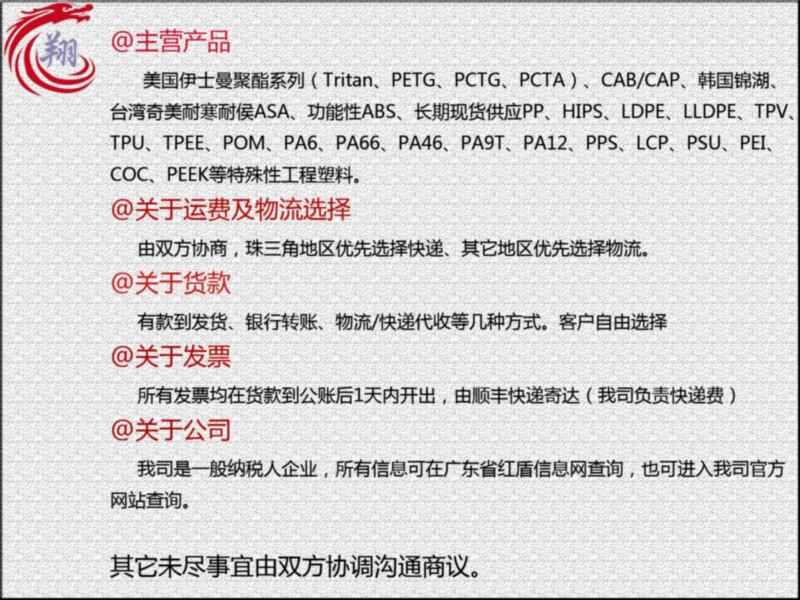厂商 :东莞畅之翔塑胶原料有限公司
广东 东莞- 主营产品:
- PP
- PETG
- PCTG
聚酯EX401高温精密部件专用/耐温109度/高透明高耐化学物性表
EX401用途:婴儿奶瓶 、吸奶器 、婴儿护理 、奶嘴(不含双酚A,过FDA检测)
EX401物性:耐化学性 、净度 、全球食品接触法规间隙 耐热性 、水解稳定性 、耐冲击性 、易于加工 、消毒可通过蒸或开水
|
Eastman Tritan? Copolyester EX401 |
||||||||
|
||||||||
| Product Description | ||||||||
|
Tritan? EX401, specifically developed for the Infant Care market, is an amorphous copolyester with excellent appearance and clarity. Tritan? EX401 contains a mold release derived from vegetable based sources. Its most outstanding features are clarity, excellent toughness, hydrolytic stability, and heat and chemical resistance. Tritan? EX401 meets infant care sterilization requirements via boiling water or microwave steam sterilization. This new-generation copolyester can also be molded into various applications without incorporating high levels of residual stress. Combined with Tritan? copolyesters outstanding chemical resistance and hydrolytic stability, these features give molded products enhanced durability in the dishwasher environment, which can expose products to high heat, humidity, and aggressive cleaning agents. Tritan? EX401 can be converted into parts using injection molding, injection stretch blow molding (ISBM), and extrusion blow molding techniques. Tritan? EX401 copolyester may be used in repeated use food contact articles under United States Food and Drug Administration (FDA) regulations. Contact Eastman representative for details on global food contact regulatory clearances. Eastman Tritan? EX401 copolyester is included in Eastman Chemical Company’s Customer Notification Procedure which details our policy for customer notification when significant changes are made in Tritan? EX401 sold into the infant care market. This procedure provides the infant care industry an added layer of confidence in the consistent quality and performance of Tritan. |
||||||||
|
|
||||||||
| Typical Properties (Preliminary) | ||||||||
| Propertya |
Testb Method |
Typical Value, Unitsc | ||||||
| General Properties | ||||||||
| Specific Gravity | D 792 | 1.17 | ||||||
| Injection Mold Shrinkage | D 955 | 0.005-0.007 mm/mm (0.005-0.007 in./in.) | ||||||
| ISBM Blow Mold Shrinkage d | EMN | 0.012-0.016 mm/mm | ||||||
| Mechanical Properties | ||||||||
| Tensile Stress @ Yield | D 638 | 44 MPa (6400 psi) | ||||||
| Tensile Stress @ Break | D 638 | 53 MPa (7700 psi) | ||||||
| Elongation @ Yield | D 638 | 7% | ||||||
| Elongation @ Break | D 638 | 140% | ||||||
| Tensile Modulus | D 638 | 1585 MPa (2.28 x 105 psi ) | ||||||
| Flexural Modulus | D 790 | 1585 MPa (2.28 x 105 psi ) | ||||||
| Flexural Yield Strength | D 790 | 66 MPa (9600 psi) | ||||||
| Rockwell Hardness, R Scale | D 785 | 115 | ||||||
| Izod Impact Strength, Notched | ||||||||
|
D 256 | 650 J/m (12.2 ft·lbf/in.) | ||||||
|
D 256 | 126 J/m (2.4 ft·lbf/in.) | ||||||
| Impact Strength, Unnotched | ||||||||
|
D 4812 | NB | ||||||
|
D 4812 | NB | ||||||
| Impact Resistance (Puncture), Energy @ Max. Load | ||||||||
|
D 3763 | 59 J (43 ft·lbf) | ||||||
|
D 3763 | 63 J (46 ft·lbf) | ||||||
| Mechanical Properties (ISO Method) | ||||||||
| Tensile Strength @ Yield | ISO 527 | 45 MPa | ||||||
| Tensile Strength @ Break | ISO 527 | 49 MPa | ||||||
| Elongation @ Yield | ISO 527 | 7% | ||||||
| Elongation @ Break | ISO 527 | 130% | ||||||
| Tensile Modulus | ISO 527 | 1624 MPa | ||||||
| Flexural Modulus | ISO 178 | 1531 MPa | ||||||
| Izod Impact Strength, Notched | ||||||||
|
ISO 180 | 66 kJ/m2 | ||||||
|
ISO 180 | 14 kJ/m2 | ||||||
| Thermal Properties | ||||||||
| Deflection Temperature | ||||||||
|
D 648 | 109°C (228°F) | ||||||
|
D 648 | 92°C (198°F) | ||||||
| Optical Properties | ||||||||
| Total Transmittance | D 1003 | 92% | ||||||
| Haze | D 1003 | <1% | ||||||
| Properties After Boiling | ||||||||
| Haze After 8 hr boiling | EMN | <1% | ||||||
| Izod Impact Strength, Notched, 23 C | ||||||||
|
EMN | 650 J/m | ||||||
|
643 J/m | |||||||
| Tensile Stress @ Yield | ||||||||
|
EMN | 44 MPa | ||||||
|
45 MPa | |||||||
| Elongation @ Yield | ||||||||
|
EMN | 7% | ||||||
|
6.5% | |||||||
| ISBM Bottle Properties | ||||||||
| Fill Volume Shrinkage - Boiling, 1 hr e | EMN | <1% | ||||||
| Fill Volume Shrinkage - Boiling, 2 hr e | EMN | <1.5% | ||||||
| Fill Volume Shrinkage - Dishwasher e | EMN | <1% | ||||||
| Microwave Steam Sterilization, Total Energy (Wattage * Minutes) e | EMN | Up to 11,200 W-min | ||||||
| Microwave Boiling, Oven Power e | EMN | Up to 2200 W | ||||||
| Thermal Shock, Water Immersion, 98 C to 35 C e | EMN | No effect | ||||||
| Typical Drying Conditions | ||||||||
| Drying Temperature | 88°C (190°F) | |||||||
| Drying Time | 4-6 hrs | |||||||
| Dewpoint | < -35°C (< -30°F) | |||||||
| Typical Processing Conditions - Injection Molding | ||||||||
| Processing Melt Temperature | 260-282°C (500-540°F) | |||||||
| Mold Temperature | 38-66°C (100-150°F) | |||||||
| Typical Processing Conditions - Injection Stretch Blow Molding (ISBM) | ||||||||
| Processing Melt Temperature | 270-285°C (520-545°F) | |||||||
| Injection Mold Temperature | 60-70°C (140-160°F) | |||||||
| Preform Temperature at Blow | 185-195°C (365-385°F) | |||||||
| Primary Blow Pressure | 0.03-0.08 MPa (4-12 psi) | |||||||
| Secondary Blow Pressure | 0.2-0.3 MPa (25-40 psi) | |||||||
| Blow Mold Temperature | 80-90°C (175-195°F) | |||||||
| Residual stress under polarized light, Fringe Count | EMN | <= 3 | ||||||
| Typical Processing Conditions - Extrusion Blow Molding (EBM) | ||||||||
| Processing Melt Temperature | 240-250°C (465-480°F) | |||||||
| Mold Temperature | 25-45°C (80-110°F) | |||||||












